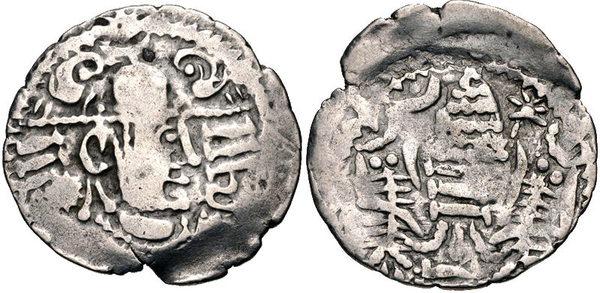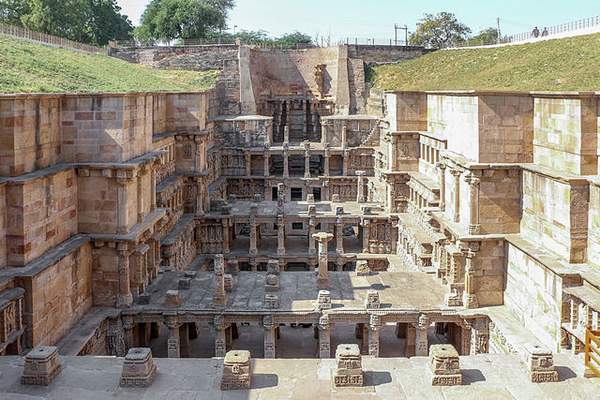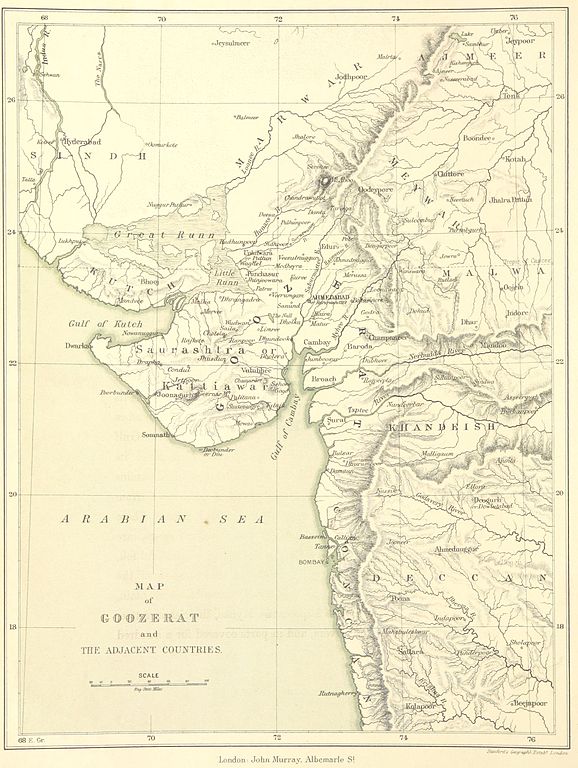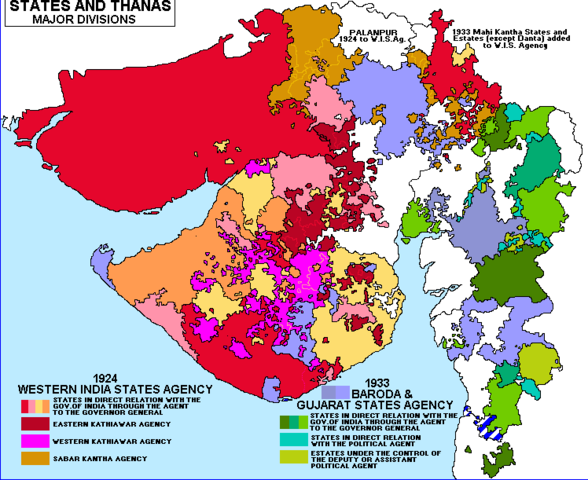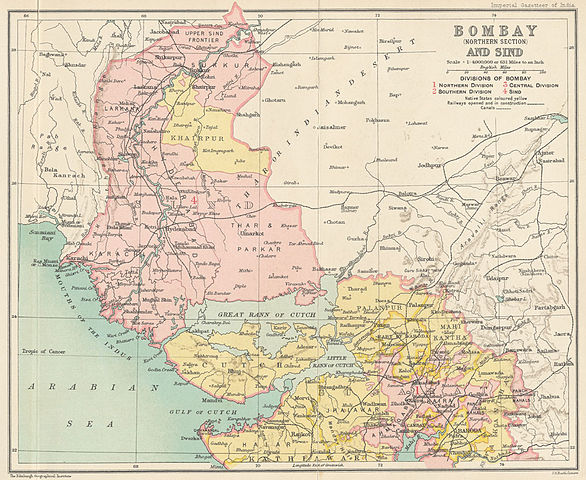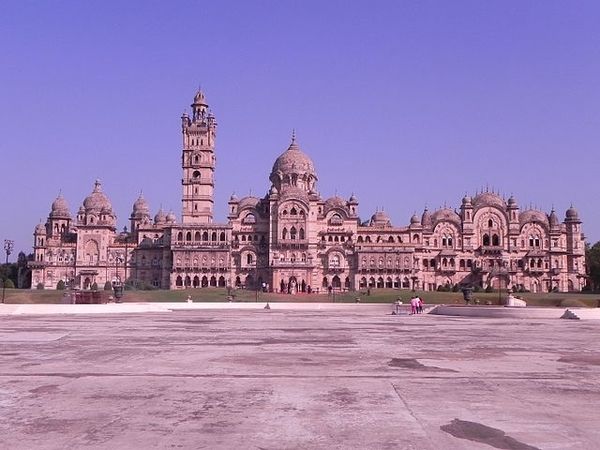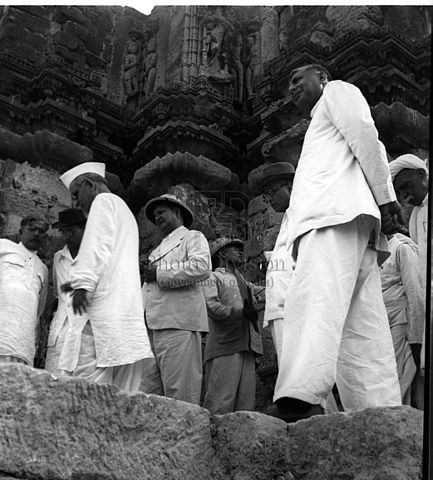
| HISTORY OF GUJARAT - 2 History
of Gujarat :
During the 10th century, the native Chaulukya dynasty came to power. From 1297 to 1300, Alauddin Khalji, the Turkic Sultan of Delhi, destroyed Anhilwara and incorporated Gujarat into the Delhi Sultanate. After Timur's sacking of Delhi at the end of the 14th century weakened the Sultanate, Gujarat's governor Zafar Khan Muzaffar asserted his independence, and his son, Sultan Ahmad Shah I (ruled 1411 to 1442), restructured Ahmedabad as the capital. The Sultanate of Gujarat remained independent until 1576, when the Mughal emperor Akbar conquered it and annexed it to the Mughal Empire as a province. Surat had become the prominent and main port of India during Mughal rule.
Later in the 18th century, Gujarat came under control of the Maratha Empire who dominated the politics of India. The British East India Company wrested control of much of Gujarat from the Marathas during the Second Anglo-Maratha War. Many local rulers, notably the Gaekwads of Baroda, made a separate peace with the British and acknowledged British sovereignty in return for retaining local self-rule. Gujarat was placed under the political authority of the Bombay Presidency, with the exception of Baroda state, which had a direct relationship with the Governor-General of India. From 1818 to 1947, most of present-day Gujarat, including Kathiawar, Kutch, and northern and eastern Gujarat were divided into hundreds of princely states, but several districts in central and southern Gujarat were ruled directly by British officials. Mohandas Gandhi, considered India's "father of the nation", was a Gujarati who led the Indian Independence Movement against the British colonial rule.
Gujarat was formed by splitting Bombay state in 1960 on linguistic lines. From 1960 to 1995, Indian National Congress retained power in Gujarat Legislative Assembly while other political parties ruled for incomplete terms in the 1970s and 1990. Bharatiya Janata Party has been in the power since 1998.
Stone Age (before 4000 BCE) :
The Middle Paleolithic sites are found from Kutch, Jamnagar, Panchmahals, Hiran valley in Saurashtra and Vapi and Lavacha of Valsad district. The Upper Paleolithic period sites from Visadi, Panchmahals, Bhamaria, Kantali, Palanpur and Vavri are also explored. The Middle (c.45,000–25,000 BP) and Late Palaeolithic artifacts include hand-axes, cleavers, chopping tools, borers, points, and scrapers. The sites in Kutch and Bhadar riverbeds in Saurashtra has also yielded stone age tools. Bhandarpur near Orsang valley is rich in Palaeolithic tools. Some of other such sites are Hirpura, Derol, Kapadvanj, Langhnaj and Shamlaji.
More than 700 sites are located in Gujarat which indicate Mesolithic/Microlithic using communities dated to 7000 BC to 2000 BC divided in Pre-Chalcolithic and Chalcolithic period. Some Mesolithic sites include Langhnaj, Kanewal, Tarsang, Dhansura, Loteshwar, Santhli, Datrana, Moti Pipli and Ambakut. The people of the Mesolithic period were nomadic hunter-gathers with some managing the herds of sheep-goat and cattle. Neolithic tools are found at Langhnaj in north Gujarat.
Chalcolithic to Bronze Age (4000 BC–1300 BCE) :
An ancient well at Lothal, and the city drainage canals Total 755 chalcolithic settlements are discovered in Gujarat belonging to various traditions and cultures which ranged from 3700 BCE to 900 BCE. Total 59 of these sites are excavated while others are studied from artifacts. These traditions are closely associated with Harappan civillization and difference between them is identified by difference in ceramics and findings of microliths. These traditions and cultures include Anarta Tradition (c. 3950–1900 BC), Padri Ware (3600–2000 BC), Pre-Prabhas Assemblage (3200–2600 BC), Pre Urban Harappan Sindh Type Pottery (Burial Pottery) (3000–2600 BC), Black and Red Ware (3950–900 BC), Reserved Slip Ware (3950–1900 BC), Micaceous Red Ware (2600–1600 BC). Prabhas Assemblage (2200–1700 BC) and Lustrous Red Ware (1900–1300 BC) are some late material cultures. The few sites associated with Malwa Ware and Jorwe Ware are also found.
Gujarat has large number of the archaeological sites associated with Indus Valley Civilization. Total 561 Classical Harappan (2600–1900 BC) and Sorath Harappan (2600–1700 BC) sites are reported in Gujarat.[8] The sites in Kutch, namely, Surkotada, Desalpur, Pabumath and Dholavira are some major sites of Urban period. The sites of the post-Urban period include Lothal B, Rangpur IIC and III, Rojdi C, Kuntasi, Vagad I B, Surkotada 1C, Dholavira VI &VII.
Iron
Age (1500–200 BCE) :
There is an insufficient archeological data for transition to the Early Historic period. This Vedic period is referenced with Vedic and Puranic sources. According to both legends and tradition, the Yadavas under Krishna inhabited of the Saurashtra peninsula of Gujarat before it came under the Mauryas. But there is no archaeological and historical evidence to prove this. There are some evidences of occupation prior to 400 BC from Dwarka, Nagara and Prabhas Patan. Bharuch was the major port town of Iron Age.
Early
Historic :
The excavated sites of the Early Historic period include Dhatva, Jokha, Kamrej, Karvan, Bharuch, Nagal, Timbarva, Akota from South Gujarat; Nagara from central Gujarat; Vadnagar, Shamlaji, Devnimori from north Gujarat and Amreli, Vallabhi, Prabhas Patan, Padri and Dwarka from Saurashtra.
Mauryas :
Gop Temple, Maitraka period.
Early Gujarat (BC 250 to 1300 AD)
Coin
of the Gujuras of Sindh, Chavda dynasty, circa 570–712 CE.
Crowned Sasanian-style bust right / Fire altar with ribbons and
attendants; star and crescent flanking flames.
Indo-scythians
:
Middle
Kingdoms (230 BCE – 1206 CE)
Gurjar-Pratihar Empire :
Rani ki Vav (The Queen's stepwell) at Patan was built in the 11th century In the early 8th century some parts of Gujarat was ruled by the south Indian Chalukya dynasty. In the early 8th century the Arabs of the Umayyad Caliphate established an Empire which stretched from Spain in the west to Afghanistan and Pakistan in the east. The Arab rulers tried to expand their Empire in the 8th century and invaded Gujarat but the Arab invaders were defeated by the Chalukya general Pulakeshin. After this victory the Arab invaders were driven out of Gujarat. Pulakeshin received the title Avanijanashraya (refuge of the people of the earth) by Vikramaditya II for the protection of Gujarat. In the late 8th century the Kannauj Triangle period started. The 3 major Indian dynasties the northwest Indian Gurjara-Pratihara dynasty, the south Indian Rashtrakuta Dynasty and the east Indian Pala Empire dominated India from the 8th to 10th century. During this period the northern part of Gujarat was ruled by the north Indian Gurjara-Pratihara Dynasty and the southern part of Gujarat was ruled by the south Indian Rashtrakuta Dynasty. Southern Gujarat was ruled by the south Indian Rashtrakuta dynasty until it was captured by the south Indian ruler Tailapa II of the Western Chalukya Empire.
Chaulukya Kingdom :
Taranga Jain Temple constructed by Kumarapala (1143 – 1172 CE) The Chaulukya dynasty [note 1] ruled Gujarat from c. 960 to 1243. Gujarat was a major center of Indian Ocean trade, and their capital at Anhilwara (Patan) was one of the largest cities in India, with population estimated at 100,000 in the year 1000. In 1026, the famous Somnath temple in Gujarat was destroyed by Mahmud of Ghazni. After 1243, the Chaulukyas lost control of Gujarat to their feudatories, of whom the Vaghela chiefs of Dholka came to dominate Gujarat. In 1292 the Vaghelas became tributaries of the Yadava dynasty of Devagiri in the Deccan. Karna of the Vaghela dynasty was the last Hindu ruler of Gujarat. He was defeated and overthrown by the superior forces of Alauddin Khalji from Delhi in 1297. With his defeat Gujarat not only became part of the Muslim empire but the Rajput hold over Gujarat lost forever.
Late
Medieval period (1206–1526 CE) :
Gujarat Sultanate (1407–1535 CE) :
Jama Masjid, Ahmedabad. Following Timur's invasion of Delhi, the Delhi Sultanate weakened considerably so the last Tughluq governor Zafar Khan declared himself independent in 1407 and formally established Gujarat Sultanate. The next sultan, his grandson Ahmad Shah I founded the new capital Ahmedabad in 1411. The prosperity of the sultanate reached its zenith during the rule of Mahmud Begada. He subdued most of the Rajput chieftains and built navy off the coast of Diu. In 1509, the Portuguese wrested Diu from Gujarat sultanate following the Battle of Diu (1509). Mughal emperor Humayun attacked Gujarat in 1535 and thereafter Bahadur Shah was killed by the Portuguese while making a deal in 1537. The decline of the Sultanate started with the assassination of Sikandar Shah in 1526. The end of the sultanate came in 1573, when Akbar annexed Gujarat in his empire. The last ruler Muzaffar Shah III was taken prisoner to Agra. In 1583, he escaped from the prison and with the help of the nobles succeeded to regain the throne for a short period before being defeated by Akbar's general Abdul Rahim Khan-I-Khana.
Early modern period (1526–1858 CE)
This
section needs additional citations for verification. Please help
improve this article by adding citations to reliable sources. Unsourced
material may be challenged and removed.
Flight
of Sultan Bahadur during Humayun's campaign in Gujarat, 1535. Folio
from an Akbarnama (History of Akbar), c. 1590.
During the next three emperors (1707–1719) who had brief reigns, the nobles became more and more powerful due to instability in the Delhi. The royals of Marwar were appointed viceroys frequently. During the reign of the emperor Muhammad Shah (1719–1748), the struggle between the Mughal and Maratha nobles were heightened with frequent battles and incursions. The south Gujarat was lost to the Marathas and the towns in north and central Gujarat was attacked on several occasions with frequent demand of tributes. The Marathas continued to grow their hold and the frequent change of viceroys did not reverse the trend. The competing houses of Marathas, Gaikwars and Peshwas engaged between themselves which slow down their progress for a while. They later made peace between themselves. During the reign of the next emperor Ahmad Shah Bahadur (1748–1754), there was nominal control over the nobles who acted on their own. There were frequent fights between themselves and with Marathas. Ahmedabad, the capital of province, fell to the Marathas in 1752. It was regained by noble Momin Khan for a short time but again lost to the Marathas in 1756 after a long siege. Finding opportunity, the British captured Surat in 1759. After a setback at Panipat in 1761, the Marathas strengthened their hold on Gujarat. During this fifty years, the power struggle between the Mughal nobles and Marathas caused disorder and the decline in prosperity.
Maratha Empire (1756–1819) :
This
section does not cite any sources. Please help improve this section
by adding citations to reliable sources. Unsourced material may
be challenged and removed.
The British also embarked upon their policy of Subsidiary Alliance. With this policy they established their paramountcy over one princely state after another. Anandrao Gaekwad joined the Alliance in 1802 and surrendered Surat and adjoining territories to the British. In the garb of helping the Marathas, the British helped themselves, and gradually the Marathas' power came to an end, in 1819 in Gujarat. Gaekwad and other big and small rulers accepted the British Paramountcy.
Colonial period (1819–1947 CE) :
This section does not cite any sources. Please help improve this section by adding citations to reliable sources. Unsourced material may be challenged and removed.
Map of Gujarat, 1866
Princely states of Gujarat in 1924 In the 1600s, the Dutch, French, English and Portuguese all established bases along the western coast of the region. Portugal was the first European power to arrive in Gujarat, and after the Battle of Diu and Treaty of Bassein, acquired several enclaves along the Gujarati coast, including Daman and Diu as well as Dadra and Nagar Haveli. These enclaves were administered by Portuguese India under a single union territory for over 450 years, only to be later incorporated into the Republic of India on 19 December 1961 by military conquest.
The British East India Company established a factory in Surat in 1614 following the commercial treaty made with Mughal Emperor Nuruddin Salim Jahangir, which formed their first base in India, but it was eclipsed by Bombay after the English received it from Portugal in 1668 as part of the marriage treaty of Charles II of England and Catherine of Braganza, daughter of King John IV of Portugal. The state was an early point of contact with the west, and the first British commercial outpost in India was in Gujarat.
Bombay Presidency in 1909, northern portion
17th-century French explorer François Pyrard de Laval, who
is remembered for his 10-year sojourn in South Asia, bears witness
accounts that the Gujaratis were always prepared to learn workmanship
from the Portuguese, also in turn imparting skills to the Portuguese:
Later in the 17th century, Gujarat came under control of the Maratha Empire that rose defeating the Mughals and who dominated the politics of India. Most notably, from 1705 to 1716, Senapati Khanderao Dabhade led the Maratha Empire forces in Baroda. Pilaji Gaekwad, first ruler of Gaekwad dynasty, established the control over Baroda and other parts of Gujarat.
Laxmi Vilas Palace, completed in 1890 is one of the largest palaces
in India. It was commissioned by Sayajirao Gaekwad III of Baroda.
Gandhi picking salt at Dandi beach, South Gujarat ending the Salt satyagraha on 5 April 1930 Gujarat was placed under the political authority of the Bombay Presidency, with the exception of Baroda state, which had a direct relationship with the Governor-General of India. From 1818 to 1947, most of present-day Gujarat, including Kathiawar, Kutch and northern and eastern Gujarat were divided into hundreds of princely states, but several districts in central and southern Gujarat, namely Ahmedabad, Broach (Bharuch), Kaira (Kheda), Panchmahal and Surat, were governed directly by British officials.
In 1812, an epidemic outbreak killed and wiped out half the population of Gujarat.
Indian Independence Movement :
Gandhi at a public rally during the Salt Satyagraha The people of Gujarat were the most enthusiastic participants in India's struggle for freedom. Leaders like Mahatma Gandhi, Sardar Vallabhbhai Patel, Morarji Desai, K.M. Munshi, Narhari Parikh, Mahadev Desai, Mohanlal Pandya and Ravi Shankar Vyas all hailed from Gujarat. It was also the site of the most popular revolts, including the Satyagrahas in Kheda, Bardoli, Borsad and the Salt Satyagraha.
Post-Independence (1947 CE – present) :
K.
M. Munshi with archaeologists and engineers of the Government of
India, inspecting the ruins of Somnath Temple, c. 1950. The temple,
which was destroyed several times by invaders, was reconstructed
in 1951.
This
section does not cite any sources. Please help improve this section
by adding citations to reliable sources. Unsourced material may
be challenged and removed.
Kutch was hit by the earthquake in 1956 which destroyed major parts of Anjar town. Gandhidham, Sardarnagar and Kubernagar were refugee settlements established for the resettlement of Sindhi Hindu refugees arriving from Pakistan after partition.
1960–1973 :
Bombay State (1956–1960) and its reorganisation Members of legislative assembly were elected from 132 constituencies of newly formed Gujarat state. Indian National Congress (INC) won the majority and Jivraj Narayan Mehta became the first chief minister of Gujarat. He served until 1963. Balwantrai Mehta succeed him. During Indo-Pakistani War of 1965, Mehta flew on aircraft to inspect Kutch border between India and Pakistan. The aircraft was shot down by Pakistan Air Force. Mehta was killed in the crash. Hitendra Kanaiyalal Desai succeeded him and won assembly elections. In 1969, Indian National Congress split into Congress (O) headed by Morarji Desai and Congress (I) headed by Indira Gandhi. At the same time, the Hindu nationalist organization Rashtriya Swayamsevak Sangh (RSS) had established itself deeply in Gujarat around this period. The riots broke out across Gujarat in September to October 1969, resulting in large number of casualties and damage to properties. Desai resigned in 1971 due to split of INC and President's rule was imposed in Gujarat. Later Ghanshyam Oza became chief minister when Indira Gandhi led Congress (I) won majority in parliament after 1971 Indo-Pakistani war. Chimanbhai Patel opposed Oza and became chief minister in 1972. The capital of Gujarat moved from Ahmedabad to Gandhinagar in 1971 but legislative assembly building was completed in 1982.
1974–2000
:
Janata Morcha government was dismissed and president's rule was imposed in 1980 even though it had majority. Later Madhav Singh Solanki led INC won the election in 1980 and formed the government which completed five years in office. Amarsinh Chaudhary succeeded him in 1985 and headed government till 1989. Solanki again became chief minister until INC lost in 1990 election following Mandal commission protests. Chimanbhai Patel came back to power in March 1990 as the head of a Janata Dal - Bharatiya Janata Party coalition government. Coalition broke just few months after in October 1990 but Chimanbhai Patel managed to retain majority with support of 34 INC legislatures. Later Patel joined the INC and continued till his death in February 1994. Chhabildas Mehta succeeded him and continued till March 1995. In 1994 plague endemic broke out in Surat resulting in 52 deaths.
Source :
http://historyofindia-madhunimkar
https://en.wikipedia.org/wiki/
|
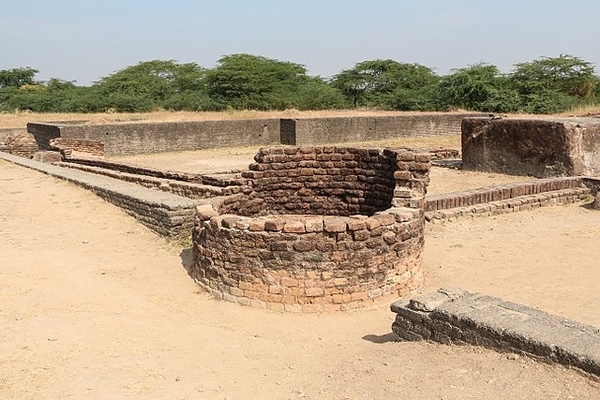
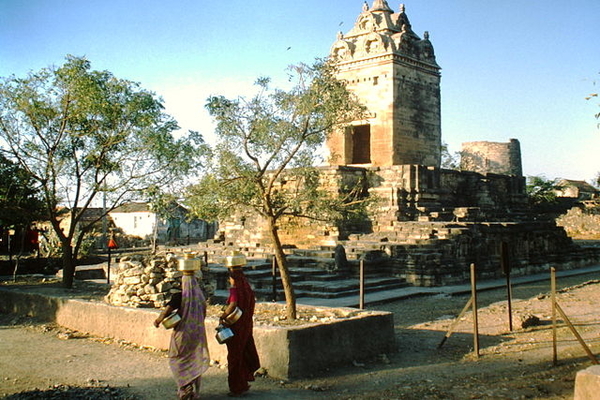
.jpg)
